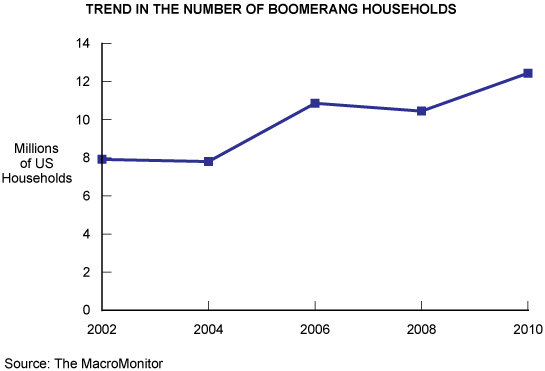MacroMonitor Market Trends November 2011
MacroMonitor Market Trends is a newsletter from Consumer Financial Decisions that highlights topical news and trends of interest to you and your colleagues. If you would like more information about the topic in the newsletter or would like to discuss other ways that we can assist you in your research and marketing efforts, please contact us.
Uh-Oh! Multigenerational Households: Growing in Number and Financially Challenged
A recent analysis of the US Bureau of Census's Current Population Survey by the AARP Public Policy Institute reports a significant increase in multigenerational households ("Multigenerational Households Are Increasing," AARP). Consumer Financial Decisions confirms the trend; the number of households financially responsible for dependent adults and the number of those with "Boomerang" children are increasing. Boomerang households alone increased from fewer than 8 million in 2002 to more than 12 million in 2010. Although some portion of multigenerational households face financial challenges, all have financial needs.

Multigenerational households are more likely than other households to:
- Have a household head between the ages of 50 and 70 (55%, in comparison with 39%)
- Be headed by a person with a high school diploma or less (51%, in comparison with 38%)
- Have an income of less than $20,000 (30%, in comparison with 19%)
- Be headed by an individual who is separated or divorced (25%, in comparison with 16%)
- Have someone in the home on Medicare (46%, in comparison with 29%) or Medicaid (24%, in comparison with 13%)
- Have recently experienced someone in the household suffering a disability (14%), suffering a major illness (12%), or retiring (8%).
Multigenerational households average 2.3 adults, in comparison with only 1.8 for other households. The presence of more household members creates a greater potential for conflicting financial priorities. Clearly, some multigenerational households are financially challenged. However, these households still have financial needs. From MacroMonitor's list of twenty-four financial needs, multigenerational households are significantly more likely than all other households to say that four needs are extremely important: protecting income, minimizing expenses, protecting savings, and planning short-term finances.
Financial Needs that Are Extremely Important to Multigenerational Households |
|||
|---|---|---|---|
| Financial Need | Multigenerational Households (Percent) | All Other Households (Percent) | Gap |
Source: 2010–11 MacroMonitor |
|||
| Replacing sufficient income if a wage earner becomes disabled | 32 | 25 | 7 |
| Minimizing basic monthly expenses | 33 | 27 | 6 |
| Protecting against loss of savings or investments | 33 | 28 | 5 |
| Planning finances out for the next one or two months | 21 | 16 | 5 |
Multigenerational households' primary concerns about retirement focus on health issues or the challenges of living on a fixed income. For their saving and investing goals, they are less likely than all other households to mention providing for retirement, saving for education, taking a vacation, buying a home, or marrying and having children; they are more likely to mention a major purchase or the purchase of a vehicle. Multigenerational households are most likely to borrow to purchase a major appliance or to pay for medical expenses. If they were to receive a $25,000 windfall, multigenerational households are more likely than other households to pay off debts (69%, in comparison with 63%) or to spend the money (48%, in comparison with 40%) rather than to save or invest (57%, comparison with 64%).
To learn more about multigenerational households' financial needs, behaviors, and attitudes, contact CFD.